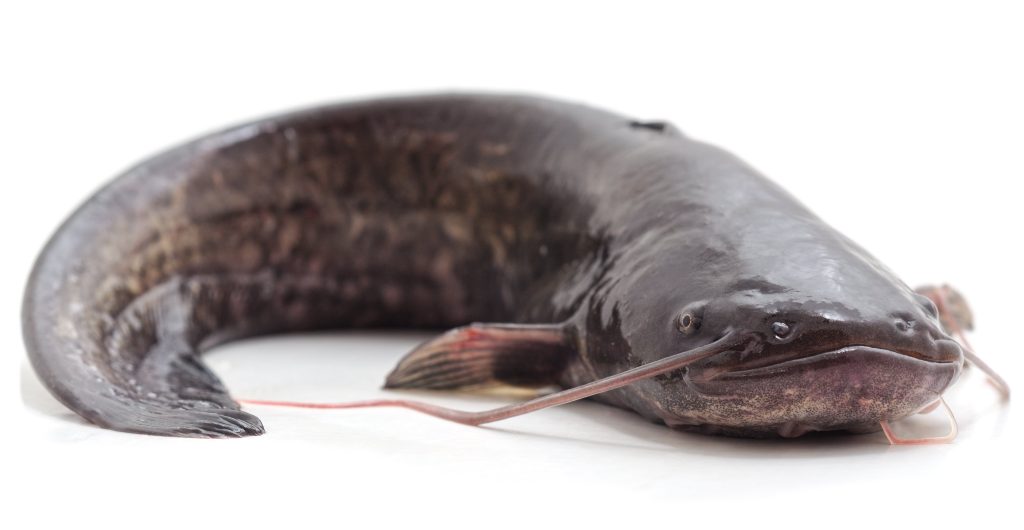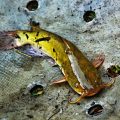The Flathead catfish belongs to the family Ictaluridae, the only fish species related to the genus Pylodictis. “Olivares” is a Greek word that means “mudfish,” while the word “Olivares” is a Latin word that means “olive-colored.”
It is different from other species of catfish due to its flat head. It is a massive fish with scaleless, smooth skin and whisker-like barbels around its mouth. Flathead catfish are 3 to 4 feet long and weigh more than 45 kg. The lower jaw of a flathead catfish is slightly extended compared to the upper jaw, and it has a pale, yellow-colored belly. That’s why it is also called a “yellow cat.” Flathead catfish have black or brown spots on their bodies and are light brown in color on the sides and back. It is the largest species of catfish found in North American freshwater bodies.

Life Span
Flathead catfish live long lives and have a lifespan of up to 24 years. However, some researchers claim that flathead catfish can live up to 28 years, but only between 5 and 22 years. The flathead catfish has a dark appearance, usually black, while its color changes with age. It is one of the fastest-growing fish except for grass carp.
They gain 2 to 5 pounds per year between the ages of 3 and 8. Their lives also depend upon the quality of the water they live in. A healthy flathead catfish can live up to years and weigh 123 pounds, if living in an excellent freshwater environment.
Habitat and environment
Flathead catfish prefer to live in turbid water where the water currents are slow. They usually live in large rivers, canals, lakes, and reservoirs. Adult flathead catfish choose pieces of debris like tree logs or driftwood near the bottom of rocks, dams, and bridges. They stay in deep water during daylight and come to shallow regions at night.
They are found in the large streams of Missouri, and the largest catfish species are found in the northern Missouri and Mississippi rivers. Their most targeted habitat is the lower Great Lakes region, passing through the Mississippi rivers to the north of Mexico and the Gulf states, where they are called invasive species.
Dietary habits
Flathead catfish are omnivorous and do not search for a specific food. Instead, they eat the food available in their region. The young one’s prey on insect larvae, shads, and shiners, and the adults eat other small catfish, worms, crustaceans, and any living creature that moves and produces vibration. They are not scavengers like other catfish species and do not eat dead and smelly material. They most likely eat crayfish, green sunfish, drum, channel catfish, gizzards, bullheads, etc. Their dietary choices change as they grow older. They usually prefer to eat at night and remain inactive during the day.
Breeding and Reproduction
The spawning period for flathead catfish is between May and August when they find a moderate temperature of 75 to 80 degrees Fahrenheit. First, they choose a safe area for laying eggs where they build their nests. It may be a tree log, bushes, pieces of rock, etc.
The female catfish lays 1200 eggs per pound of its body weight and can lay up to 60,000 eggs at a time. The nest they create can contain 10,000 eggs piled over each other, but very few of them survive because of water pollution. It takes six to nine days for the fertilized eggs to hatch. The young flathead catfish remain in the nest for a few days before finally separating. Male flathead catfish take care of the laid eggs and nest. They use their fins to produce water currents near the nest so that the eggs may get oxygenated water for their growth. Unfortunately, poor dietary habits and flood conditions affect the spawning ability of flathead catfish.
Relationships with Humans
Because of their survival and availability in freshwater bodies, flathead catfish are very important to anglers. Their flesh is considered one of the tastiest kinds of seafood. Their survival, they are also displayed in public aquaria. Sportfishing for flathead catfish was considered exciting in the past.
Anglers make use of different rods and reels to catch them. They use live bait and sound-producing elements to attract catfish because they are sensitive to vibrations. They consider deep water a good flathead catfishing spot because of moderate water currents and a large number of live baits. Most anglers use clonking and noodling techniques to catch them.
Is Flathead Catfish Good Food for People?
Flathead catfish are good seafood to eat because of their low amount of mercury. Mercury can be dangerous to the human nervous system if consumed in large quantities. Flatheads are considered one of the finest table seafood dishes. It can be steamed, grilled, or fried. It is a rich source of omega-3 fatty acids, minerals, and vitamin B-12. Its smooth flesh makes it a delicious source of lean protein.
It can be used in the diet for weight loss because it makes a person feel full. The omega-3 fatty acid found in it is very helpful in improving memory loss and neurological conditions. The vitamin B-12 present in it is beneficial for protection against heart diseases and treating anemia. Flathead catfish are low in calories and can provide more nutritional value if baked or broiled rather than fried.
Conclusion
The flathead catfish is one of the most important species in the world for conservation efforts. It’s also a delicious food source and an exciting catch for anglers. Next time you find yourself fishing in Florida or New York, keep an eye out for these amazing fish—you never know when one will pop up next to your hook.












Pingback: Differences Between a Catfish Rod and a Grouper Rod | Reel Fishing Guru
Pingback: What is a Mud Catfish? | Reel Fishing Guru
Pingback: Will Catfish Eat Anchovies? | Reel Fishing Guru
Pingback: How Many Catfish Are There in the United States? | Reel Fishing Guru
Pingback: Do Catfish Eat Crappie? | Reel Fishing Guru